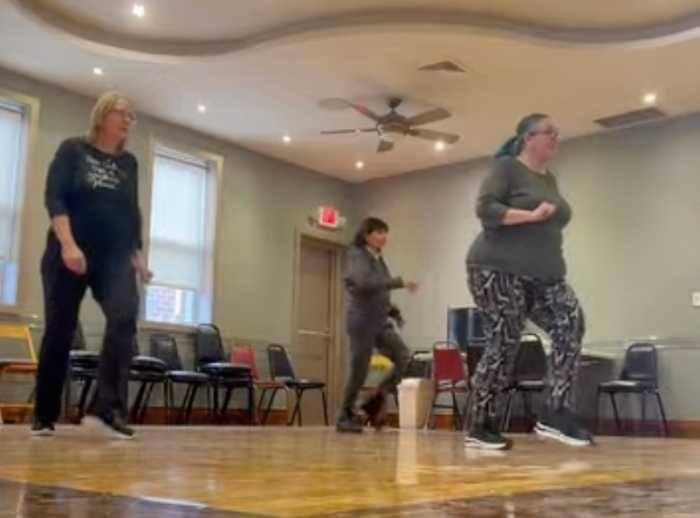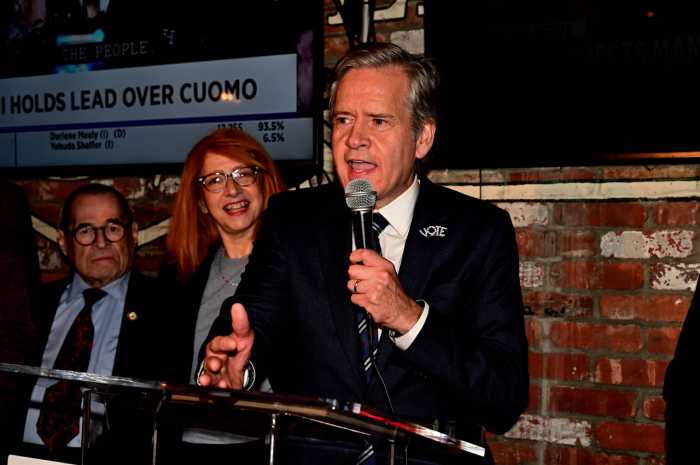Council Member Julie Won has once again outlined that she will vote against the OneLIC Neighborhood Plan unless the comprehensive neighborhood rezoning includes specific community guarantees — including a commitment to provide deeply affordable housing, over 1,300 new school seats, a substantial increase in open space, and a comprehensive plan to improve resiliency in the neighborhood.
Won made the promise during a City Council hearing on the neighborhood plan on Wednesday as the plan makes its way through the city’s Uniform Land Use Review Procedure (ULURP) and questioned a number of city agencies about the potential impact of the rezoning.
OneLIC, which covers 54 full or partial blocks in the neighborhood, aims to create roughly 14,700 new housing units in Long Island City, including roughly 4,300 affordable homes. The OneLIC plan, proposed by the Department of City Planning and the Adams Administration, aims to create over 14,400 new jobs for the neighborhood alongside over 3.5 million square feet of commercial and industrial space. The plan also aims to expand access to the East River waterfront.
Won, however, has consistently stated that she will vote against the plan when it goes before the City Council in the fall unless it includes iron-clad commitments to the Long Island City community.
She reiterated that stance at Wednesday’s City Council hearing, when representatives from several city agencies fielded questions from Won and Zoning Committee Chair Kevin Riley. The agencies included the Department of City Planning (DCP), the New York City Economic Development Corporation (EDC), Housing Preservation & Development (HPD), the Parks Department, and the Department of Transportation (DOT).
Won spoke of the need to build more schools in the neighborhood to cope with the continued growth of the Long Island City population. She called on city agencies to commit to adding 1,300 new school seats by the time of the Council vote, adding that current projects such as the Court Square School will not count toward that tally.
She also called for commitments to providing more open space in the neighborhood as part of the rezoning. The OneLIC plan currently plans to add around six acres of open space by fully connecting the Long Island City waterfront from Gantry Plaza State Park to Queensbridge Park, while the DCP said the plan will contain incentives for private developers to build open space in areas away from the waterfront.
Won, however, expressed shock when she learned that LIC currently boasts 0.9 acres of open space for every 1,000 residents, far below the DCP’s stated goal of 2.5 acres per 1,000 residents.
“I don’t think six acres is going to cut it,” Won said.
Won says city must ‘equally invest’ in LIC

Won has frequently called for a number of city-owned lots underneath the Queensboro Bridge to be converted into open space as part of the rezoning. She said the lots formerly made up Queensbridge Baby Park and called on the Parks Department to include the 15 lots in its ongoing renovation of the former park. Advocates have argued that the Parks Department is only renovating a small section of the former park, which opened in 1939 and had been a vital resource for families residing in Queensbridge Houses.
Won called on city agencies to commit to deeply affordable housing as well as bringing vacant units at Queensbridge Houses and Ravenswood Houses back on line.
“Without these commitments to address everyone of these priorities, OneLIC will not have my support,” Won said at Wednesday’s hearing.
In a statement issued after Wednesday’s hearing, Won said OneLIC represented an opportunity to “right the wrongs” of decades of underinvestment in the neighborhood. She said LIC had “borne the brunt” of the city’s housing construction but said the city has failed to “equitably invest” in key infrastructure such as sewage, school seats, open space and resiliency.
At present, Won added, the neighborhood plan does not do enough to address those issues.
“Supporters and opponents of OneLIC all agree: this plan does not go far enough,” Won said in a statement. “Until the city commits more resources to match the caliber of its ambitious rezoning, I will not be supporting it.”
Speaking during the hearing, Won also outlined her willingness to “try again next year” under a different mayoral administration if her demands are not met. She said she aims to finalize commitments to those demands over the coming weeks.
State Sen. Kristen Gonzalez also addressed Wednesday’s hearing and said any neighborhood plan should create affordable housing and “intentionally benefit” the community it is serving.
“Without binding commitments from developers and city and state agencies, this plan can pass through the infrastructure gaps that many of us already live with,” Gonzalez said.
She said Long Island City currently faces significant infrastructure issues, stating that the neighborhood’s sewers struggle to keep pace during storms and that the neighborhood’s green space has been “stretched thin.”
Wednesday’s hearing heard many of the same arguments that have been voiced about OneLIC since the neighborhood plan entered the public engagement process around two years ago.
Since its launch in November 2023, the plan has drawn mixed reactions. Supporters argue that it would bring much-needed housing, jobs and community amenities to Long Island City, while critics contend that the proposal favors developers and could lead to the displacement of lower-income residents currently living in the neighborhood.
Those arguments were again evident on Wednesday as around 100 local residents and community leaders gave testimony at an hours-long hearing at City Hall.
A number of speakers who expressed support for the plan did so only on the condition that a number of community benefits were included, such as guaranteed renovation of the Jacob A. Riis Neighborhood Settlement community center in Queensbridge and a commitment to providing space for arts and culture.

Edjo Wheeler, executive director of Culture Lab LIC, said there are currently 112 arts and culture organizations located within the area covered by OneLIC but said there is “no mention” of arts and culture in the current plan.
“If we don’t build structural incentives or requirements for free or low-cost space into this plan, they (arts and culture organizations) will disappear once the buildings fill up,” Wheeler said at Wednesday’s hearing.
Patricia Cooper, a long-time Queensbridge resident, said she has watched “rezonings come and go” in the more than 20 years that she has lived in Long Island City. However, she said Queensbridge has largely stayed the same during that time, with residents frequently dealing with broken plumbing, crumbling infrastructure and “buildings that have been neglected for decades.”
Cooper and several other Queensbridge residents said the plan represented a once-in-a-generation opportunity to address those issues, but only if it provides guaranteed commitments to the Queensbridge community.
“We need real, written and enforceable capital commitments to repair and renovate,” Cooper said in her testimony. “Without that accountability, this plan must not unfold. We’ve been patient for decades. Now we are demanding action.”
A number of residents who spoke out against the plan raised concerns that OneLIC would drive up prices, adding that the plan represented a “luxury development plan.”
Donal Cogdell Jr., a minister at the Hope Astoria Church, said he had received letters from over 40 parishioners who are concerned by the impact of the OneLIC plan.
“There’s only one class of people that this plan seems to be serving,” Cogdell told the hearing. “And it’s not (for) all of New York.
“We have housing insecurity and people who are looking to stay in their homes,” he added. “This plan does not help them stay in their community.”
Astoria resident Andrea Mungo contended that the plan does not cater for “the poor, the struggling artist, the small business owner and small manufacturers” who currently reside in Long Island City.
“I am calling for responsible and just development that truly meets the needs of low and middle-income, singles and families who do not have generational wealth, double incomes or high-paying jobs,” Mungo said in her testimony.
Others spoke in favor of the plan, arguing that OneLIC would help address the city’s current 1.1% vacancy rate and improve the area’s infrastructure.
Kirsten Bladh, policy manager at pro-housing advocacy group Open New York, argued that “outdated zoning” is adding to New York’s housing shortage by “standing in the way” of building the homes that the city needs. She said Long Island City would be “squandering” an opportunity if the OneLIC plan is not passed.
“The OneLIC plan will help to correct a profound mismatch by allowing for the construction of over 14,000 homes and new employment centers that better reflect the needs and future of the city,” Bladh said.
Laura Rothrock, president of the Long Island City Partnership (LICP), said the organization “strongly supports” OneLIC because the neighborhood plan will create a more “inclusive, connected and sustainable” Long Island City.
A number of speakers, including Won, raised concerns about the plan’s environmental impacts, including the strain that adding over 14,000 new homes would place on the area’s flood mitigation.
Representatives from the DCP and the Department of Environmental Protection (DEP) said any property measuring over 20,000 square feet constructed as part of OneLIC will be required to handle an 1.5 inches of rainwater, roughly matching what many of the city’s sewers can handle.
DEP representatives said such measures will greatly reduce the volume of water entering the city’s sewers, asserting that the proposed development would be more helpful than harmful to the area’s stormwater management.
DEP officials further stated that the agency is set to install flood net technology systems to provide real-time monitoring of flood levels in the area, while it is also set to unveil a drainage plan for Long Island City next year.
Lin Zeng, director of the DCP’s Queens office, said a similar neighborhood plan in Gowanus has already helped improved resiliency in the neighborhood.





































